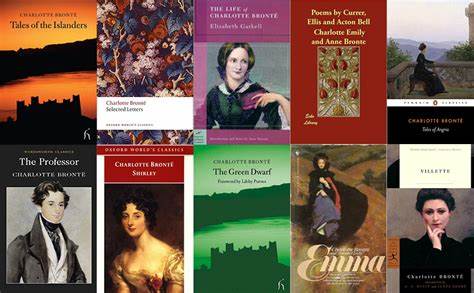
The Brontë sisters, Charlotte, Emily, and Anne, are towering figures in English literature. Their works continue to captivate readers worldwide, with compelling narratives and deep explorations of human emotions and societal themes. This guide provides a detailed overview of their books in order, highlighting their profound literary contributions.
1. Charlotte Brontë’s Books in Order
Jane Eyre (1847)
Charlotte Brontë’s masterpiece, published under the pseudonym Currer Bell, is an enduring classic. Jane Eyre tells the story of an orphaned girl navigating love, independence, and morality. The novel’s themes of resilience, feminism, and redemption resonate deeply, making it a cornerstone of English literature.
Shirley (1849)
Set against the backdrop of the Industrial Revolution, Shirley explores themes of social unrest and gender roles. This novel reflects Charlotte’s nuanced storytelling, addressing societal and personal struggles.
Villette (1853)
Based on Charlotte’s own experiences at a Belgian boarding school, Villette delves into themes of loneliness, unrequited love, and identity. This introspective work showcases her mastery of psychological realism.
The Professor (1857)
Although written before Jane Eyre, The Professor was published posthumously. It provides an intriguing look into Charlotte’s evolving literary style and focuses on the life of an Englishman teaching in Belgium.
2. Emily Brontë’s Sole Masterpiece
Wuthering Heights (1847)
Published under the pseudonym Ellis Bell, Emily Brontë’s Wuthering Heights is a landmark of English literature. This haunting tale of love, revenge, and the supernatural is set on the windswept Yorkshire moors. Its complex narrative structure and vivid characters like Heathcliff and Catherine make it one of the most studied and celebrated novels of all time.
Emily also penned nearly 200 poems, showcasing her lyrical prowess and emotional depth. Her poetry remains a testament to her creative genius.
3. Anne Brontë’s Literary Contributions
Agnes Grey (1847)
Anne Brontë, writing as Acton Bell, made her debut with Agnes Grey. This semi-autobiographical novel draws on her experiences as a governess, shedding light on social class disparities and the plight of women in Victorian England.
The Tenant of Wildfell Hall (1848)
Regarded as one of the first feminist novels, The Tenant of Wildfell Hall boldly critiques societal norms, marital oppression, and alcoholism. Anne’s portrayal of a strong, independent heroine solidifies her place among the greats of English literature.
4. The Pseudonyms and Legacy of the Brontë Sisters
The Brontë sisters initially wrote under male pseudonyms: Currer Bell (Charlotte), Ellis Bell (Emily), and Acton Bell (Anne). This choice reflected the gender biases of their time, allowing them to publish works without prejudice. Together, they challenged literary conventions and paved the way for future women writers.
Their collective works dealt with themes of love, societal constraints, morality, and human nature. Whether it’s the eerie moors of Wuthering Heights, the inspiring journey of Jane Eyre, or the courageous defiance in The Tenant of Wildfell Hall, the Brontë sisters left an indelible mark on literature.
5. Insights into Their Lives and Inspirations
The Early Years
Born in the village of Thornton and raised in Cowan Bridge and Haworth, the Brontë siblings endured personal tragedies that shaped their writing. Their mother died young, leaving their father, Patrick Brontë, to raise them with the help of an aunt. The harsh conditions at Cowan Bridge School (the model for Lowood School in Jane Eyre) left a lasting impression on the sisters.
Elizabeth Gaskell’s Biography
Charlotte’s close friend and fellow novelist, Elizabeth Gaskell, chronicled her life in The Life of Charlotte Brontë. This biography provides valuable insights into the family’s struggles, triumphs, and enduring legacy.
6. The Brontë Sisters’ Lesser-Known Works
Beyond their novels, the sisters created a wealth of juvenile literature, including poetry and short stories. These early works, though less celebrated, provide a fascinating glimpse into their creative development.
- Charlotte’s Poetry: Her poems, though overshadowed by her novels, reveal her keen observation and emotional depth.
- Emily’s 200 Poems: A testament to her literary brilliance, Emily’s poetry explores themes of nature, solitude, and spirituality.
- Anne’s Contributions: Anne’s poetic works often reflect her compassionate and introspective nature.
7. Why the Brontës Matter Today
The works of Charlotte, Emily, and Anne Brontë remain relevant due to their timeless exploration of universal themes. Their novels are not just literary achievements but also bold commentaries on society, gender roles, and human emotions. Whether you’re a devoted fan or a newcomer, the Brontë sisters offer a literary journey that’s both enriching and transformative.
For anyone wishing to delve deeper into the Brontë sisters’ legacy, their novels provide a profound understanding of 19th-century England and the human condition. Start with their books in order to experience their literary evolution firsthand.